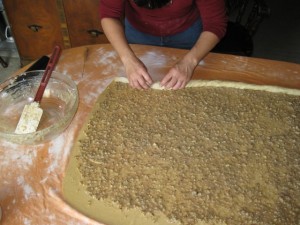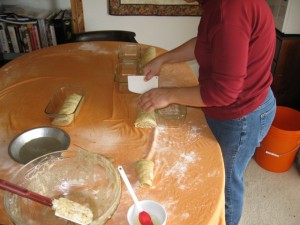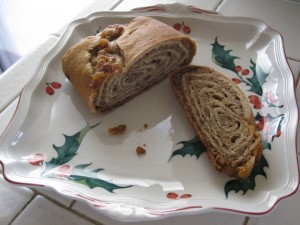Several years ago, when my mother-in-law told me that she rarely got potiça for the holidays, and no one made it any more, I vowed to find out what this mysterious substance was and make some for her as a surprise. Only I didn’t know how to spell it. It took a while for me to find out, because potiça is actually pronounced “poe-TEETS-ah”. Yeah, not what I’d call obvious. At least, not if you’re not Slovenian. (:
So, what is this mysterious potiça? It’s a Slovenian yeasted bread, stuffed and rolled with a walnut-honey mixture. Some people add raisins. I think it’d be good that way, but I haven’t done it that way yet. It’s time-consuming to prepare, because of the double-rise and the rolling, and because I have to make two batches, or we don’t get any!
I use a recipe from a Slovenian cookbook entitled More Pots and Pans, put out by the Slovenian Women Union of America. My mom-in-law gave it to me. It’s a pretty cool book — I’ve made some other recipes out of it. I make a variant on the “especially for beginners” recipe. This is my version.
Walnut Potiça
- 4 1/2 tsp. rapid-rise yeast
- 3 1/2 c. white flour
- 3 c. whole-wheat flour (not traditional, but I find that it really complements the filling well)
- 4 Tbsp. sugar
- generous pinch salt
- zest of 1 lemon, grated (I like Meyer lemons)
- 1/2 c. milk
- 4 egg yolks, well beaten (reserve the whites for the filling)
- 1 c. sour cream
- 1 stick (1/4 lb) butter
- 1 c. half-and-half
Mix the beaten egg yolks and sour cream. Set aside. Melt the butter with the half-and-half and set aside to cool slightly.
Combine the white flour, whole wheat flour, yeast, sugar, salt, and lemon zest in the bowl of a large stand mixer. You can also knead this by hand, of course. I have shoulder problems, so the mixer is a big help for me, and it makes it go quickly. Add the egg yolks and sour cream, the butter and half-and-half, and the milk. Mix until the liquid is absorbed. You should have a nice soft dough. If you don’t, add more milk.
Knead in the mixer or by hand until you have a smooth and elastic dough. It will take about 10 minutes by hand, 4-5 in the mixer.
Place the dough in a large greased bowl (I use spray oil), turn the dough upside-down to grease the top, and cover with a damp towel. Set aside to rise in a warm place for about an hour and a half, or until the dough is doubled in bulk. Meanwhile, make the filling, and grease four bread pans and a pie pan for the ends.
Walnut Filling
- 1 stick (1/4 lb) butter
- 1 c. half-and-half, heated
- 1 1/2 lb. ground walnuts (a nut grinder is traditional, but I don’t have one. I grind mine in the food processor. You do get a slightly different texture if you use a nut grinder, but the potiça is equally tasty either way.)
- 1 1/2 c. sugar
- 3/4 c. honey (I use California wildflower honey, which is my favorite. Different honeys will give the filling different flavors — use what you like best.)
- 1 Tbsp. vanilla extract (I use Penzey’s double-strength vanilla)
- 4 egg whites, beaten to stiff peaks
Heat the butter in the half-and-half until melted. Pour the hot mixture over the ground walnuts. Add the sugar, honey, and vanilla and mix well. Fold in the beaten egg whites.
Assemble the Bread
When the dough has doubled, turn it out onto a floured cloth or sheet large enough to roll the dough to 30 x 40″. A table pad or quilt under the sheet will make rolling easier. Roll the dough out into a 30 x40″ rectangle from the center, using only enough flour to keep it from sticking.
Spread the walnut filling evenly over the dough, covering the entire surface except for 1″ on the wide end to be rolled last. I usually spread the filling with my hands. It’s sticky, but faster and you get a smoother coat.
I don’t usually bother to trim the dough to shape, because everyone likes the little gooshy edges where the filling has escaped. But if you want to make it look a little more even, you can square up the dough and trim the edges off. Roll these up like cinnamon rolls and put them in the greased pie plate to bake off.
Start rolling the dough with your fingers, tightly at first and tugging and stretching lightly as you roll. Try to keep the side edges as even as possible.
When you’re halfway through rolling, take a skewer or cake tester (you can see mine in the picture above) and prick the roll about every two inches, going about halfway through. This helps release air bubbles. Continue to roll until you’re at that 1″ you left bare. Paint that with egg white to help the seam seal (I find that the filling always tries to squish out into that area), and finish rolling up. Prick the dough again about every 2 inches.
When the dough is rolled up, you’ll need to cut it to fit. Their recommendation is a plate, which works fine — I’ve done that before. I also have a bench scraper, which is what I’m using in this picture. Whatever you’ve got will work.
Trim off the ends and put them into the pie plate, then cut each loaf to fit your pans. Place them in the pans, cover with a damp towel, and set aside in a warm place to let double in bulk, about 1 hour. Preheat your oven to 325°F.
When the dough is fully proofed, you can brush the top with a mixture of cream and sugar, but I always forget. My potiça never gets a glaze. Oops. I actually don’t think it needs it; it’s plenty sweet on its own. Bake the loaves and the ends at 325°F for an hour and 10 minutes. Keep an eye on the ends, but they’re usually fine.
Remove from the pans and let cool for 20 minutes, then remove from pans and allow to cool completely on a wire rack.
So much work, right? Wouldn’t you say the results are worth it, though? And this is just one of the end bits.



It’s fun to see pictures of the project that we so happily consumed! Thanks again, by the way. 🙂